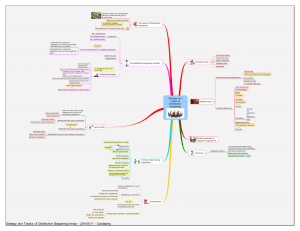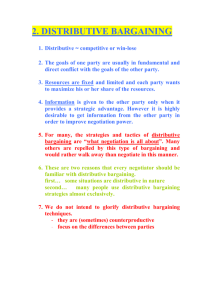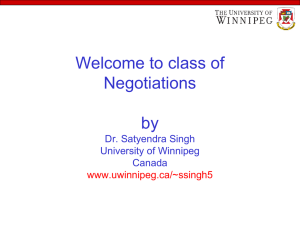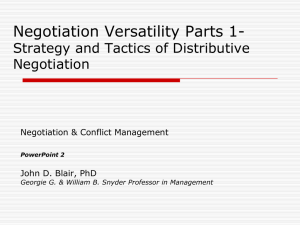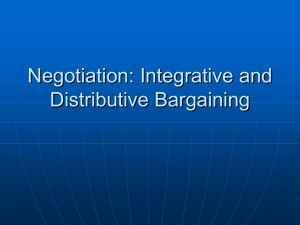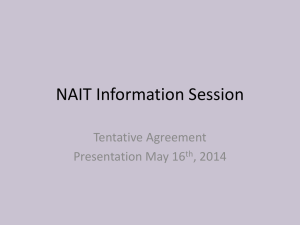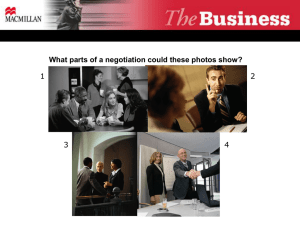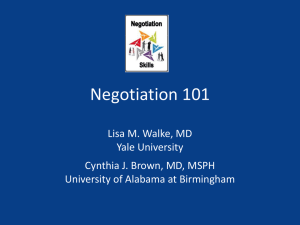distributive-winter 2012
advertisement
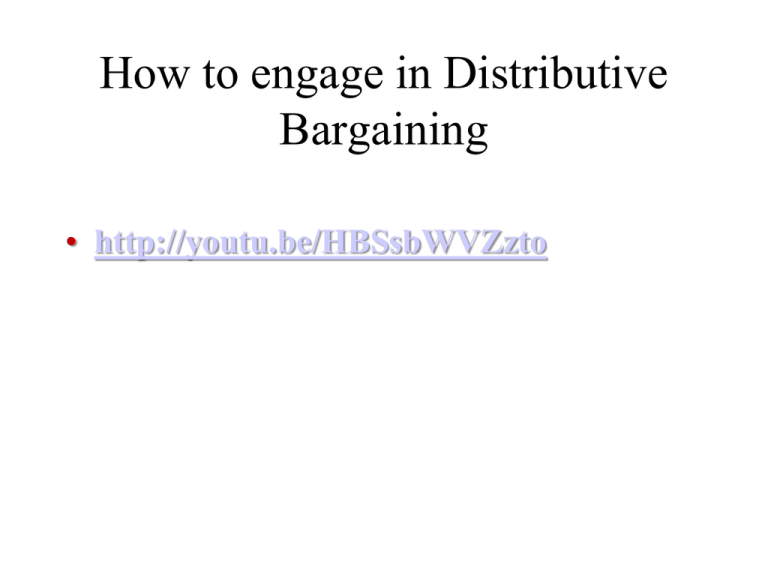
How to engage in Distributive Bargaining • http://youtu.be/HBSsbWVZzto Agenda Definition of distributive bargaining Contrast with integrative Why use it Terms used in Distributive bargaining Strategies Tactical Tasks Positions Commitment Closing Definition of Distributive Bargaining Limited & fixed amount of resources Goal conflict Each maximizes getting share of resources available to oneself No focus on relationship Informational context Each provides very little information while trying to extract the most from the other Why learn about Distributive Bargaining? Some situations demand it Most people use it Can be useful at the ‘end-stage’ of an integrative bargaining situation Creating issues, creating value, claiming value When to use Distributive Bargaining? Single issue e.g., this session’s exercise Relationship is not important Terms used in a Distributive Bargaining Situation • • • • Target point Resistance point Initial offer Bargaining range • Zone of potential agreement (ZOPA) or settlement range – Implications of Positive & negative bargaining range • Best Alternative to Negotiated Agreement • Settlement point • http://youtu.be/5fmY3JV6iNI (the basics of distributive bargaining) QUANTITATIVE STRUCTURE OF THE NEGOTIATION Buyer’s Target Buyer’s Resistance Price Buyer’s Initial Offer 5 10 15 20 25 30 35 ZOPA Seller’s Resistance Point Seller’s Target Seller’s Initial Offer ZOPA = Zone of Potential Agreement. Students write….. • On the basis of your role, and guessing things about the other role’s write out the following for each role on handout • • • • Target point Resistance point Opening offer Best Alternative to Negotiated Agreement Plan your side & guess other party’s side Target Point Your side Other party’s side Opening Offer Resistance Point BATNA Students write….. • Based on your plan, write out the following for the upcoming negotiation on a line graph • • • • Target point Resistance point Opening offer Bargaining range • Zone of potential agreement (ZOPA) or settlement range • Best Alternative to Negotiated Agreement • Settlement point Plan/Guess ZOPA & Settlement Points Strategy vs. Tactics • Strategy – have a future long term relationship with the other party – How much and what kind of information you will share which will guide tactics of conceal vs. reveal • Tactics – Short-term, dynamic – Specific behaviors • types of questions used, listening behaviors, brainstorming options for mutual gain Strategies used in Distributive Bargaining •Push for settlement near other’s resistance point •Make extreme offers and small concessions •Convince other to change his/her resistance point •Increase bargaining range •Create a positive settlement range •Convince other it was the best possible deal •Not that it is all they can get, or they are incapable of getting anymore, or they are losing Four Tactical Tasks in Distributive Bargaining 1. Assess Other Party’s resistance point, target point, and costs for stopping Negotiation 2. Manage Other’s Impressions of your target point, your resistance point and the cost of stopping negotiation 3. Modify Other’s Perceptions 4. Manipulate Actual Costs of Delay or Termination 1st Tactic: Assess other party’s resistance point Factors affecting other party’s resistance point Other party’s resistance point + Other’s party’s lower value of a particular issue +/Other’s vs. your cost to delaying/stopping negotiations So ask and give information appropriately! +/Other’s party’s perception of how much you value issue First Offer Opening Stance Concessions Steps in Distributive Bargaining Final Offer How First Offers Work First Offer Anchoring Final outcome of First Offer maker How to mitigate the effect of First Offers First Offer Other Party’s Focus on own target point Anchoring Final Outcome of First Offer maker Other party’s focus on first offer maker’s resistance point • First Offers (FO) • Creates advantage to offer maker • Exaggerated FO get higher settlements – Creates room for negotiation – Meta-messages to other party » (long way to go, needs to make more concessions, leads other to think they mis-perceived resistance point) – disadvantages=can be rejected, conveys attitude of toughness and breeds retailiation • Those with better BATNA make first offer • Opening Stance – What you say…with your offer – Competitive vs. moderate • Results in other party to respond in kind – Should be consistent with first offer or it could be confusing • Initial Concessions – Initial Offer and counteroffer=bargaining range • Or reject initial offer – Symbolic messages in initial concessions – Packet of opening offer, opening stance, initial concessions display firm vs flexible stance • Firmness creates a climate of negotiation that is either reciprocated, or shortens negotiations • Concessions – Progression of Decreasing vs. increasing sizes of concessions and reciprocation • Across issues = logrolling in integrative bargaining – Size of concession & occurrence in negotiation sequence • Signals resistance point, target point, interpret ratios of concessions – Try out different packages, sweeten the end • Not all issues are worth the same to both negotiators = integrative bargaining skill • Final Offers • Statement vs. using concession to convey ‘final offer’ • Problem If other party does not recognize final offer .. • May lead to negative feelings – Can make the last concession more substantial to signal final offer stage… Last points… • http://www.youtube.com/watch?v=4XizDMfgVjM (Jack failed to negotiate well with his nanny on her salary)
